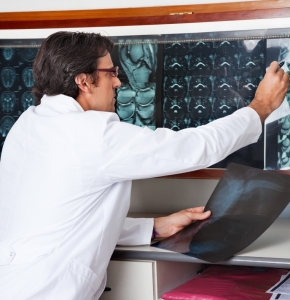Lead Apron Storage
Improper storage of your lead apron can reduce the attenuating qualities of the apron and ultimately reduce the level of radiation protection your apron provides. Lead apron storage racks come in a variety of styles and configurations to meet the specific needs of your medical facility.Protection From Radiation Exposure
Lead aprons are used in medical facilities to protect workers and patients from x-ray radiation exposure from diagnostic radiology procedures. Lead aprons are protective garments that have been designed to shield the body from the harmful effects of ionizing radiation during medical imaging procedures.
“As is the case with many protective garments, it is important to remember that a lead apron is only effective when it is worn properly, matched with the appropriate radiation energy and is used in a safe and regularly inspected environment.” – Stanford’s Radiation Protection Guidance for Hospital Staff¹
Lead Apron Integrity Check
Medical personnel who are required to wear lead aprons or other related radiation protection devices should visually inspect these protective garments prior to each use for obvious signs of damage such rips and tears, sagging lead, and cracks in the lead lining.
Not sure if a lead apron rack is necessary?
1. To ensure that you are properly protected. When a lead apron hasn’t been stored properly, you could be putting yourself at risk for increased exposure to ionizing radiation. Small cracks and holes can develop in the lead lining that may not be visible on the exterior fabric of the lead apron.
“Lead aprons should be checked fluoroscopically at least on an annual basis for their shielding integrity” ² [ ncradiation.net/xray/documents/leadapronsgud.pdf ]” -Radiology Compliance Branch (Radiation Protection Section), NC Department of Health and Human Services
2. To protect your radiation protection investment. Properly storing your lead aprons will extend the useful life of the apron by helping prevent damage to the lead lining and the exterior fabric of the lead apron. Aprons should never be folded or creased. Lead aprons should be hung up by the shoulder(s) or on an approved apron hanger. Aprons should not be stored on a flat surface. Even incorrect storage for a short time can result in damage that is not visible to the naked eye.
3. To improve the organization of lead aprons. Managing lead aprons is one task that the imaging director has to cross off their to-do list, although it is probably not at the top of their list. Lead aprons play a vital role in protecting physicians, imaging staff, and patients from unnecessary exposure to ionizing radiation during diagnostic imaging procedures. Properly organizing your aprons will simplify the tracking process and will make State or Joint Commission inspections easier.
4. To help improve efficiency. Having a centralized location to properly store lead aprons will keep them safe and easily accessible the next time they are needed. Properly managing lead aprons can be a time-consuming task, utilizing an appropriate lead apron storage rack can help reduce time spent tracking aprons in the medical facility. As departments grow, it is important to have an apron storage process in place to keep aprons from getting mixed between departments.
5. To help reduce the occurrence of missing aprons. Keeping track of aprons can be difficult, especially when physicians and imaging staff spend time at multiple facilities. Lead apron racks make storage easier and help reduce the chance of lead aprons getting moved between departments and other medical facilities.
Example of A Wall Mounted Apron Rack
Stay Neat And Organized
Maintaining a neat, uncluttered imaging environment is important in detail orientated medical fields. Lead apron racks allow your facility to provide medical staff with a well-organized treatment facility and workspace. When the necessary equipment is readily available on an x-ray apron rack in a centralized location, X-ray procedures will be completed efficiently and effectively.

Leave a Reply